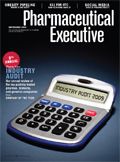An Essential Bed Check
Mastery of internal factors can mean the difference between thriving and failing in an environment where industry is a price taker, not a price setter.
Today's corporation carries legal status as an individual. But this doesn't guarantee it has the human capacity for self-awareness. That's one of the ironies revealed in Pharmaceutical Executive's Eighth Annual Industry Audit. The key metric for corporate success today rests on a simple maxim: Know thyself.

William Looney
Professor Bill Trombetta notes that uncertain times demand disciplined, grounded management—understanding customer needs and achieving consistent execution around clear, well-communicated objectives; scouring the organization for internal process improvements while remaining ready to strike with "game-changing" innovations that can deliver organic growth for the long term.
Evidenced by this year's winners, superior performance around these standard business practices is a critical element in moving from a profitability model geared toward boosting sales—an increasingly difficult feat—to one focused on risk-adjusted return on investment. Mastery of internal factors, such as lowering costs or raising asset productivity, can mean the difference between thriving and failing in an environment where industry is increasingly a price taker, not a price setter.
This year's Industry Audit suggests that smaller biotech and generics companies—what we refer to as "stealth pharmas"—perform better on this score than the Big Pharmas. Perhaps sharper focus comes with having less to manage.
This back-to-basics approach is reinforced by McKinsey & Co. research on improving the productivity of R&D. Besides highlighting the deteriorating financials of R&D investment (the average internal rate of return has dipped to a historic low of 7.5 percent, meaning that it now costs a drugmaker more to develop a medicine than the company gets from selling it), McKinsey concludes that three simple internal efficiency measures can revive R&D performance: Cost Management, especially through outsourcing and risk-sharing of selected R&D activities on a functional and geographic basis; Speed to Market, by fixing process gaps that often relay the wrong signals on clinical trial progress; and Focused Decision-Making, to secure early consensus around the real drivers of development risk, such as failure to differentiate the value of a compound from competitors in its class.
Under conditions of unprecedented market volatility, success depends on striking a balance between stability—and stretch. A fading blockbuster model accentuated by growing payer constraints on demand means that companies must find growth from new sources. The traditional approach to market leadership has to be turned on its head: learning how to spin profits from commodity segments like generics; finding better price points to serve the unmet health needs of lower income patients in emerging countries; moving from saturation promotion to more selective targeting of diverse KOLs.
This cocktail for change is most potent when mixed as one part creativity and two parts common sense. Behind the 2008 Audit data is the message that industry "c-suiters" will earn their keep by devising new ways to compete without yielding on the traditional tools of strong management—executing efficiently and doing more with less.
That's a message worth recognizing, and we at Pharm Exec intend to follow it as well. In the weeks and months ahead, we want to reach out to the readership to clarify our strengths, identify where we can improve, and stretch our potential as the key "reputation read" in the life sciences industry.
William Looney
Editor-in-Chief
Addressing Disparities in Psoriasis Trials: Takeda's Strategies for Inclusivity in Clinical Research
April 14th 2025LaShell Robinson, Head of Global Feasibility and Trial Equity at Takeda, speaks about the company's strategies to engage patients in underrepresented populations in its phase III psoriasis trials.
Beyond the Prescription: Pharma's Role in Digital Health Conversations
April 1st 2025Join us for an insightful conversation with Jennifer Harakal, Head of Regulatory Affairs at Canopy Life Sciences, as we unpack the evolving intersection of social media and healthcare decisions. Discover how pharmaceutical companies can navigate regulatory challenges while meaningfully engaging with consumers in digital spaces. Jennifer shares expert strategies for responsible marketing, working with influencers, and creating educational content that bridges the gap between patients and healthcare providers. A must-listen for pharma marketers looking to build trust and compliance in today's social media landscape.
